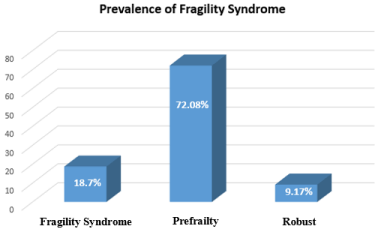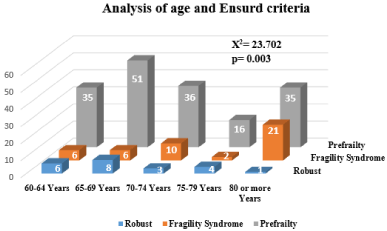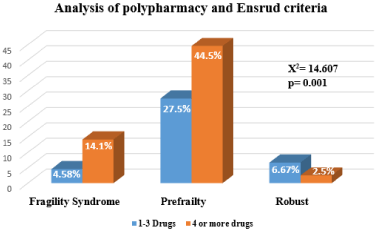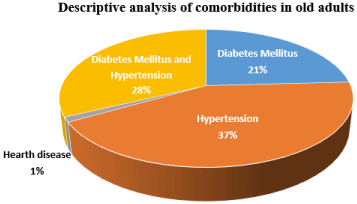Abstract
Background: In recent years the population of older adults has increased; this phenomenon leads to an increase in the diseases associated with age, among them the frailty syndrome of the elderly. This syndrome is a health problem that is sometimes not identified by the health personnel or is not given the corresponding importance. Once this disease is identified, an appropriate and timely diagnosis and treatment should be established; what will give the older adult a better quality of life.
Aim: The purpose of this study is to determine the prevalence of frailty syndrome and associated factors in old adults in Cd. Juarez, Chihuahua.
Design and Setting: Comparative cross-sectional study.
Methods: In 240 patients in the Family Medicine Unit #46, Cd. Juarez, Chihuahua, the Ensurd criteria were applied to assess the presence of frailty among the participants and to make an association between the following variables: age, sex, comorbidities, marital status, coexistence, occupation and polypharmacy. For statistical analysis, association was established with chisquared test for statistical significance, it was used 95% interval confidence (p‹0.05).
Results: We obtained a prevalence of frailty syndrome of 18.75%, pre-frailty 72.08% and robust 9.17% according to the criteria of Ensurd. When making an association between Ensurd criteria and the variables collected, the following significant results were found: age (p=0.003), polypharmacy (p=0.001). Of the total population (n=240), 21.3% have diabetes, 37.1% hypertension, 0.4% heart disease, 28.3% diabetes and hypertension and 2.5% without comorbidities.
Conclusion: In this study it was found that the frailty syndrome is present in older adults, and a high percentage presents pre-frailty. It was observed that comorbidities (chronic degenerative diseases), age and polypharmacy are related to the problem and if it is not detected in a timely manner, the functional capacity and quality of life of the elderly will be seriously affected.
Keywords: Frailty Syndrome; Older Adults; Ensurd Criteria
Introduction
The prevalence and incidence of frailty is variable, with percentages between 33-88%. The prevalence in Latin America is between 30-48% in women and 21-35% in men. The prevalence in Mexico is 39%, more frequently in women than in men (45% vs. 30%) [1]. Fragility is a physiological syndrome characterized by reduced reserves and reduced resistance to stressors as a result of the cumulative decline of multiple physiological systems that increase vulnerability for adverse health outcomes. Some authors distinguish primary frailty as that caused by multiple physiological decline associated only with aging and secondary frailty that is associated with diseases or even disability [2]. Older adults are vulnerable mainly to chronic diseases, sensory medical alterations such as vision, hearing, malnutrition, polypharmacy, cognitive deterioration, depression, dependence on basic and instrumental activities of daily life, alteration in walking and deficiency in social support; it is frequent that the older adult does not express all his discomforts, due to shame or because of the type of attention in the classic consultation, where the time for medical attention is decreasing; all this makes it difficult to recognize diagnostics [3].
Within the syndrome of frailty one of the risks that exist are falls, which are cause of increase in morbidity and mortality in older adults. The incidence of falls and the severity of complications increases after the age of 60; in developed countries, accidental falls are listed as the fifth cause of death in older adults, after cardiovascular diseases, cancer, stroke and lung disorders [4]. Among the systems involved in the frailty syndrome is the cardiovascular, neuroendocrine, metabolic, immune system and skeletal muscle system. There are two physical changes associated with aging and may be the main cause of frailty: sarcopenia and osteopenia. The loss of muscle mass and power is a universal loss, occurs over the years, even in people who regularly perform moderate physical exercise. The muscle mass decreases by 3-8% per decade from the age of 30. This produces a progressive decrease in strength and contributes to the disability and loss of independence of the elderly. Fragility and sarcopenia overlap, most frail elderly people have sarcopenia and many of the elderly with sarcopenia are fragile [2].
In practical terms, the frail patient is one who is delicate in health, weak and not vigorous or robust. It is a syndrome that carries a high risk of mortality, disability, institutionalization, hospitalizations, falls, fractures, postoperative complications, poor health and even venous thromboembolism [1]. It is recommended to use the proposal of Ensurd and collaborators to detect frailty syndrome, which consists of assessing 3 criteria: loss of weight of 5% regardless of whether it was intentionally or not in the last 3 years, inability to get up from a chair five times without using the arms, reduced energy level using the question: Do you feel full of energy? Considering a NO, as a response for 1 point. Its interpretation is as follows: 0 points= Sturdy patient, 1 point= pre-frail patient, 2 or 3 points= fragile patient [1]. The objective of this study is to know the prevalence of frailty syndrome in old adults and to know the associated risk factors, in order to implement preventive measures and comprehensive treatment in the medical attention.
Materials and Methods
A comparative cross-sectional study was carried out, in the Family Medicine Unit #46, of the Instituto Mexicano del Seguro Social (IMSS), located in Cd. Juarez, Chihuahua; in patients which were selected by a consecutive sampling techniques; that met the following inclusion criteria: age of 60 years or more, any sex, that accepted and signed an informed consent; patients with disability were not included and eliminated those who did not complete the survey or those with incomplete information.
The following data were obtained directly from the patients or medical records: age, sex, marital status, occupation, polypharmacy, comorbidities and coexistence. The procedure for the data collection was as follows: age was calculated in years according to the year of birth, sex was determined by the phenotype characteristics of each individual, marital status was expressed by each patient, occupation was determined by asking directly to patients, polypharmacy was evaluated according to the number of medications that the patient has prescribed, comorbidities was evaluated according to the presence of chronic diseases and coexistence was determined by the presence of more than one family member in the home where the elderly person lives.
The recollected data was integrated into data collection sheets and analyzed using the SPSS program version 22 in Spanish, where we applied descriptive statistics; for qualitative variables, frequencies and percentages were used and for quantitative variables, mean and standard deviation were used. For the bivariate analysis, the Chisquare test was used in the dichotomous qualitative variables to determinate statistically significant differences between the groups (with fragility syndrome and without fragility syndrome). The Kolmogorov-Smirnoff test was used to establish the normality of the data. It was considered a p< 0.05 as statistically significant, with a 95% confidence interval. The Protocol was authorized by the Local Committee of Research and Ethics in Health Research from the Family Medicine Unit #46, where this study took place.
Results
We analyzed a sample of 240 patients, of whom 143 (59.6%) were women and 97 (40.4%) men. A prevalence of the fragility syndrome of 18.75% was obtained, 72.08% pre-frailty and 9.17% robust according to the criteria of Ensurd (Graphic 1). When making an association between age and Ensurd criteria, we found that in the 60-64 age group (n=47), 6 with frailty were found, 35 with prefragility and 6 robust; in the group 65-69 years (n=65), were found 6 with fragility, 51 individuals with pre-frailty and 8 robust; in 70-74 years group (n=49) were found 10 with fragility, 36 prefragility and 3 robust; in 75 to 79 years (n=22), 2 were found with fragility, 16 pre-fragile and 4 robust; in the 80 years group (n=57), 21 with fragility, 35 prefragility and 1 robust. (Graphic 2). The association between age and Ensurd criteria has a value of X2= 23.702 and p= 0.003.

Graphic 1: Prevalence of Fragility Syndrome.

Graphic 2: Analysis of age group and Ensrud criteria.
It was found that 19.6% of men have frailty syndrome and 70.1% prefragility, in female sex 18.18% have fragility and 73.4% prefragility. The association between sex and Ensurd criteria has no statistical significance with a value of X2= 0.381 and p= 0.826. The comorbidities, polypharmacy, coexistence, marital status and occupation with frailty syndrome were related, where it was found that 38.75% of the patients use between 1 to 3 drugs daily and 61.25% use 4 or more drugs daily (polypharmacy) (Graphic 3). The association with the Ensurd criteria has a value of X2= 14.607 and p= 0.001. The 83.75% of patients live with a family member, 12.91% live alone and 3.34% live in an asylum. The association of coexistence and criteria of Ensurd resulted with a value of X2= 5.685 and p= 0.224. The occupation of participants was 60% pensioned, 20% work in the home and 20% work in a formal job.

Graphic 3: Analysis of polypharmacy and Ensrud criteria.
In the association of the criteria of Ensurd and comorbidities the following results were obtained: of the total of patients with frailty (n= 45) 6 have diabetes, 11 hypertension, 12 with diabetes and hypertension, 4 with heart disease, diabetes and hypertension and 12 with heart disease and hypertension; of the total of individuals with pre-frailty (n= 173), 40 have diabetes, 60 hypertension, 1 heart disease, 54 with diabetes and hypertension, 1 with diabetes, hypertension and heart disease, 8 with heart disease and hypertension and 3 without comorbidities; of the total of robust individuals (n= 22), 5 have diabetes, 2 hypertension, 2 with diabetes and hypertension and 3 without comorbidities (Graphic 4 and Table 1). The association has a value of X2= 56,877 and p= 0.001. Of the total population (n= 240), 21.3% have diabetes, 37.1% hypertension, 0.4% heart disease, 28.3% with diabetes and hypertension, 2.1% heart disease, diabetes and hypertension, 8.3% hypertension and heart disease, 2.5% without comorbidities (Graph 4).
Prefrailty
Fragility syndrome
Robust
p
Comorbidities (n)
Diabetes Mellitus
40
6
5
X2= 56.877
p= 0.001
Hypertension
66
11
12
Hearth disease
1
0
0
Diabetes Mellitus and Hypertension
54
12
2
Without comorbidities
3
0
3
%: Percentage, n: Frequency, X2: Ji-Square value, p: Ji-Square.
Table 1: Analysis between fragility syndrome and comorbidities.

Graphic 4: Descriptive analysis of comorbidities in old adults.
Discussion and Conclusion
In this study we obtained a sample of 240 adult patients over 60 years, 97 men (40.4%) and 143 women (59.6%), a prevalence of frailty syndrome of 18.75%, 72.08% pre-frailty and 9.17% robust was obtained according to the criteria of Ensurd. Regarding the age group, it was found that as age increases, the risk of frailty syndrome also increases. The increase in life expectancy is a phenomenon that leads to an increase in the diseases associated with age, among them is the frailty of the elderly, considered as a geriatric syndrome. We can see that the prevalence is lower than the national average, but it is still important that the population is aging and with it increases the appearance of geriatric syndromes and their complications.
The relationship between age and Ensurd criteria found in the present study indicate that there is a statistically significant association value (p= 0.003), the age with the highest prevalence of frailty is in people aged 70-74 years, we also find a high percentage of pre-frailty in people aged 60-69 years. In addition to diseases, falls generate functional dependence in older adults, those who have already fallen once are at risk of falling again or are afraid of repeating the experience and intentionally limits their movement which generates dependency [5].
In sex, it was found that the prevalence is higher in men, however there is no statistical relevance between sex and Ensurd criteria. The comorbidities, polypharmacy, coexistence, marital status and occupation in this syndrome were related. Regarding polypharmacy, an association was made with the Ensurd criteria with a statistically significant p value (p= 0.001), which indicates that fragility is directly related to polypharmacy and age. Coexistence, marital status and occupation are not factors that predispose fragility. It is important to prevent frailty syndrome, start working with the young adult to become an older adult with a better physical condition, prevent the development of comorbidities or treat them in a timely manner. The comorbidities that had the most prevalence in this study were diabetes and hypertension alone or in combination in the same patient, the relationship with Ensurd criteria indicates that there is a relationship between diabetes-hypertension and frailty. Our population of older adults has a high percentage of pre-frailty and also have comorbidities that increase the risk of frailty.
In this study it was found that the frailty syndrome is present in the elderly, and that there is a high percentage of patients who already have pre-frailty. It was observed that comorbidities such as chronic degenerative diseases, age and polypharmacy are related to the problem and if not treated in a timely manner, the functional capacity and quality of life of the elderly will be significantly affected. It is necessary to work with the functional capacity of older adult through general and specific interventions such as the regular practice of physical exercise, periodic evaluation with the Folstein minimental test, application of scales to assess cognitive deterioration and presence of depression and use of orthopedic devices for the march for prevention of falls in the elderly. We consider that the actions currently implemented are focused on treating the problem of fragility once it has been presented and preventing complications; however, a prevention approach in young adults is necessary to avoid the development of frailty syndrome and work with patients already detected with pre-frailty.
References
- Diagnóstico y Tratamiento del Síndrome de Fragilidad en el Adulto Mayor. Guia de practica clínica, México: Secretaría de Salud; 2014.
- Romero-Cabrera AJ. Fragilidad y enfermedades crónicas en los adultos mayores. Med Int Mex. 2011; 27: 455-462.
- Cervantes-Becerra RG, Villarreal-Ríos E, Galicia-Rodríguez L, Vargas-Daza ER, Martínez-González L. Estado de salud en el adulto mayor en atención primaria a partir de una valoración geriátrica integral. Aten Primaria. 2015; 47: 329-335.
- Kalula SZ, Ferreira M, Swingler GH, Badri M. Risk factors for falls in older adults in a South African Urban Community. BMC Geriatr. 2016; 16: 1-11.
- Manrique-Espinoza B, Salinas-Rodriguez A, Moreno-Tamayo K, Tellez-Rojo MM. Functional dependency and falls in elderly living in poverty in Mexico. Salud Publica Mex. 2011; 53: 26-33.
